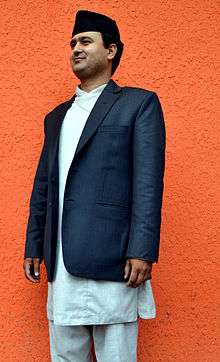Daura-Suruwal


Daura-Suruwal or Labeda Suruwal, is a traditional and former national costume of Nepal worn by men.[1] It is also worn by neighboring Indian people of Nepali Origin of Sikkim and Darjeeling. The equivalent female national costume is the Gunyou Cholo. The coat was added to the costume by Jang Bahadur Rana, Prime minister of Nepal in the 19th century. Daura is a variant of Kurta and the upper wear and Suruwal is the trouser. Daura Suruwal has several religious beliefs identifying its designs and has remained the same for centuries. The Daura has eight strings denoted as Astamatrika-Singini as follows.
- Byagini
- Kumari
- Barahi
- Brahmayani
- Indrayani
- Maheshowri
- Byasnabi
- Mahalaxmi
The Nepalese Prime Minister Bir Shamsher Jang Bahadur Rana wore the Daura-Suruwal on an unofficial visit to the United Kingdom in the 19th century, which popularized it further in Nepal. In 2017 B.S., (1960), the Daura-Suruwal was designated the national uniform for men in government positions. The use of the outfit as a government uniform or as a popular form of clothing has declined since that time, but also has increased use among Nepali nationalists in the Darjeeling province of India. History tells Rana Prime Minister Janga Bahadur Rana introduced coat in Nepal in the 19th century. He was presented gift of coat by Queen of England. He started the tradition of wearing coat on the Daura suruwal. From then the tradition of wearing Daura with Suruwal became Daura Suruwal and Coat. Men wear Daura Suruwal with East Coat (Waist Coat) too. This combination is a kind of informal wear.
In 2017 B.S. Daura Suruwal was announced as national dress for men in government services and other national programs. Daura suruwal took a great pace of development in those years. Very few of Nepali now wear Daura Suruwal. After 2046 B.S none of the elected or interim governments is able to define and announce any national the national dress. Now, there is no such dress or uniform that we can point our officially as Nepali. We still regard Daura suruwal as National dress of Nepal. Now Daura Suruwal is now confined only in the list of national signs and as groom’s wedding dress. None of the members of constitutional assembly or any leader hardly wear any uniform as we can say national. The new generation may hardly own a pair of Daura-Suruwal.
The dress is stated as an official as it has been confined only in the list of national signs and the officials under the panel of His Majesty's Government. The new generation hardly owns a pair of Daura-Suruwal, and majority of them wouldn't prefer this outfit. Unlike Nepali women's attire-'Sari' is winning its appearance in the fashion world. Daura-Suruwal, the Nepali national dress is not that fashionable among men. However, the dress is well-known among its lovers and it is successful to establish its own image in the market. We wish it will soon reach its popularity in the global market. We are slowly forgetting our traditional values and nationalities. We love Daura Suruwal and all Nepali traditional dresses from Mountain, Hill and Terai. We can at least announce something as our national dress which represents Nepal. There should be something we should wear and say this is “Nepali”.
Religious Belief of Daura Suruwal
Daura-Suruwal, typically termed ‘Labeda-Suruwal’ is the traditional Nepali dress. The dress has several religious beliefs identifying its designs and remained the same from the years. The Daura has eight stringscalled, ‘Astamatrika-Singini, Byagini, Kumari, Barahi, Brahmayani, Indrayani, Maheshowri, Byasnabi, and Mahalaxmi’, that serves to tie itself up around the body and eight is a lucky number according to our mythology. Also, the Daura has five pleats or Kallis, signifying Pancha Buddha or Pancha Ratna. And the closed neck of the Daura signifies the snake around the Lord Shiva’s neck.
References
- ↑
- ↑
- ↑ "MYREPUBLICA.com - News in English from Nepal: Fast, Full & Factual News". myrepublica.com. Retrieved 25 May 2015.
- ↑ "Darjis for Darj - Nepali Times". nepalitimes.com. Retrieved 25 May 2015.